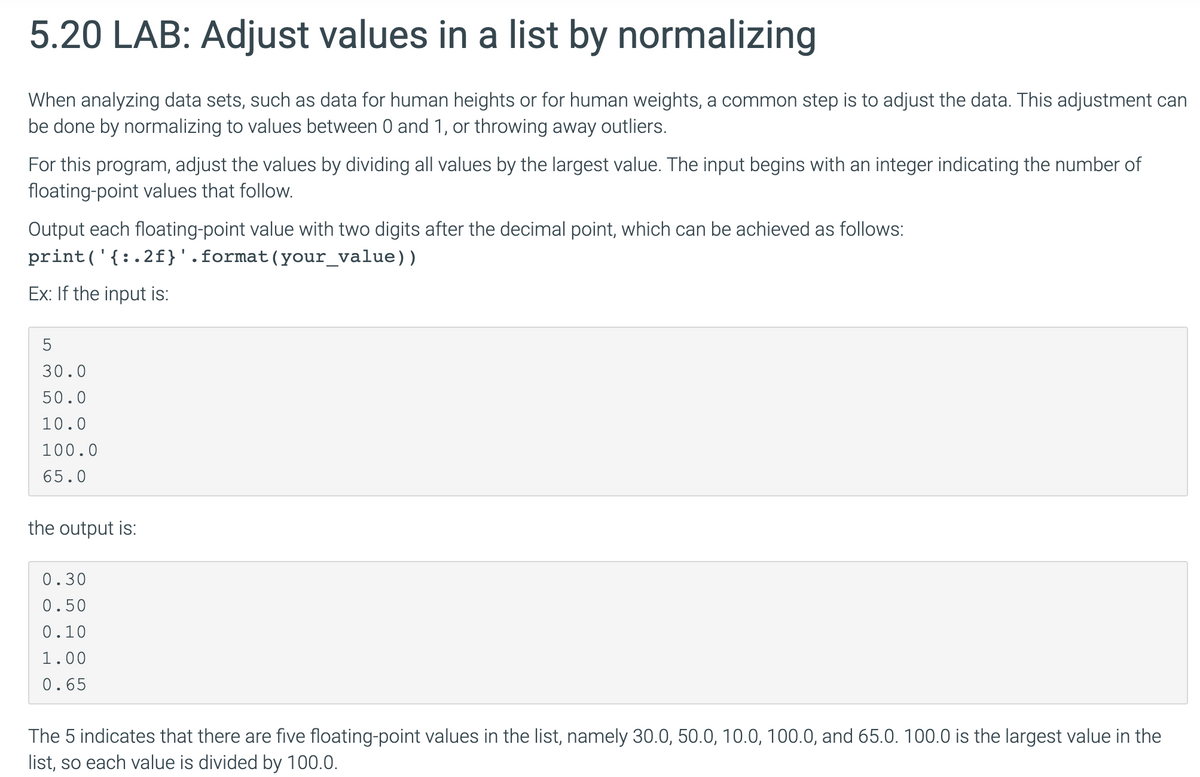5.20 LAB: Adjust values in a list by normalizing When analyzing data sets, such as data for human heights or for human weights, a common step is to adjust the data. This adjustment can be done by normalizing to values between 0 and 1, or throwing away outliers. For this program, adjust the values by dividing all values by the largest value. The input begins with an integer indicating the number of floating-point values that follow. Output each floating-point value with two digits after the decimal point, which can be achieved as follows: print('{:.2f}'.format(your_value)) Ex: If the input is: 30.0 50.0 10.0 100.0 65.0 the output is: 0.30 0.50 0.10 1.00 0.65 The 5 indicates that there are five floating-point values in the list, namely 30.0, 50.0, 10.0, 100.0, and 65.0. 100.0 is the largest value in the list, so each value is divided by 100.0.
5.20 LAB: Adjust values in a list by normalizing When analyzing data sets, such as data for human heights or for human weights, a common step is to adjust the data. This adjustment can be done by normalizing to values between 0 and 1, or throwing away outliers. For this program, adjust the values by dividing all values by the largest value. The input begins with an integer indicating the number of floating-point values that follow. Output each floating-point value with two digits after the decimal point, which can be achieved as follows: print('{:.2f}'.format(your_value)) Ex: If the input is: 30.0 50.0 10.0 100.0 65.0 the output is: 0.30 0.50 0.10 1.00 0.65 The 5 indicates that there are five floating-point values in the list, namely 30.0, 50.0, 10.0, 100.0, and 65.0. 100.0 is the largest value in the list, so each value is divided by 100.0.
C++ Programming: From Problem Analysis to Program Design
8th Edition
ISBN:9781337102087
Author:D. S. Malik
Publisher:D. S. Malik
Chapter17: Linked Lists
Section: Chapter Questions
Problem 11SA
Related questions
Question
dont post copied answers posting multiple times sure dislike

Transcribed Image Text:5.20 LAB: Adjust values in a list by normalizing
When analyzing data sets, such as data for human heights or for human weights, a common step is to adjust the data. This adjustment can
be done by normalizing to values between 0 and 1, or throwing away outliers.
For this program, adjust the values by dividing all values by the largest value. The input begins with an integer indicating the number of
floating-point values that follow.
Output each floating-point value with two digits after the decimal point, which can be achieved as follows:
print('{:.2f}'.format(your_value))
Ex: If the input is:
30.0
50.0
10.0
100.0
65.0
the output is:
0.30
0.50
0.10
1.00
0.65
The 5 indicates that there are five floating-point values in the list, namely 30.0, 50.0, 10.0, 100.0, and 65.0. 100.0 is the largest value in the
list, so each value is divided by 100.0.
Expert Solution
This question has been solved!
Explore an expertly crafted, step-by-step solution for a thorough understanding of key concepts.
This is a popular solution!
Trending now
This is a popular solution!
Step by step
Solved in 4 steps with 2 images

Recommended textbooks for you

C++ Programming: From Problem Analysis to Program…
Computer Science
ISBN:
9781337102087
Author:
D. S. Malik
Publisher:
Cengage Learning

C++ for Engineers and Scientists
Computer Science
ISBN:
9781133187844
Author:
Bronson, Gary J.
Publisher:
Course Technology Ptr

C++ Programming: From Problem Analysis to Program…
Computer Science
ISBN:
9781337102087
Author:
D. S. Malik
Publisher:
Cengage Learning

C++ for Engineers and Scientists
Computer Science
ISBN:
9781133187844
Author:
Bronson, Gary J.
Publisher:
Course Technology Ptr